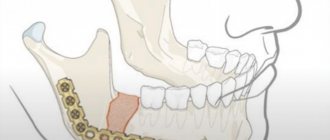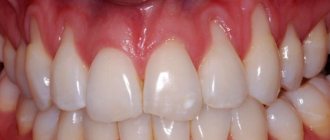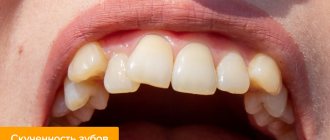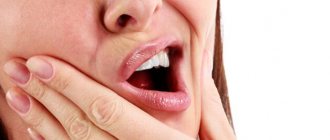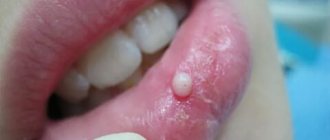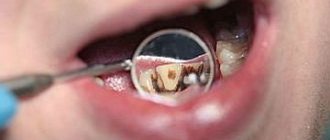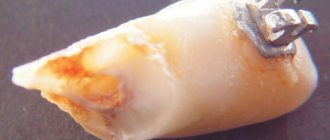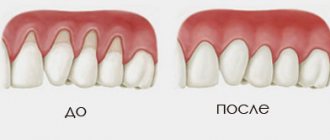Non-carious lesions that occur before eruption
Before birth, during the so-called period of follicular development of teeth, the following types of diseases occur:
- Enamel hypoplasia is a malformation of hard tissue due to disturbances in protein and mineral metabolism. The disease manifests itself in the form of spots and depressions, the enamel on which has reduced hardness or is absent altogether.
- Tetracycline teeth are one of the types of hypoplasia that develops as a result of exposure of a pregnant mother or newborn child to antibiotics of the tetracycline group. The substance accumulates in the body and stains the teeth yellow, sometimes brown.
- Fluorosis is formed as a result of the penetration of excessive amounts of fluoride into the body. Residents of areas with high levels of fluoride in water and aluminum industry workers are at risk. The disease manifests itself in the form of yellow-brown spots and stains, while the enamel becomes dull.
Dental hypoplasia
The pathology is manifested by underdevelopment or absence (aplasia) of tooth enamel; It can be congenital, but also develops after the birth of a child due to insufficient intake of minerals into the body. Hypoplasia itself refers to non-carious lesions of teeth, but thanks to it, excellent conditions are created in the oral cavity for the development of microbes, including those that cause caries.
Causes of hypoplasia:
- metabolic disease;
- mechanical damage to the jaw bone;
- dystrophy;
- diseases of the gastrointestinal tract;
- developmental pathologies;
- During pregnancy, the woman had: severe toxicosis, rubella, ARVI, toxoplasmosis, conflict of Rh factors, as well as premature birth and birth trauma.
Symptoms of hypoplasia
Pathology can be systemic (affects all teeth) and local (affects several teeth). In the early stages, underdevelopment of the enamel (too thin a layer or complete absence), deformation of the teeth and the appearance of grooves, yellow and white spots on their surface are noted. Painful sensations are noted during meals, and later, in the absence of treatment, the tissues are destroyed (erased) and an abnormal bite is formed.
Treatment of hypoplasia
Since underdevelopment of hard tissues and tooth decay is associated with a lack of minerals, when treating hypoplasia, it is necessary to remineralize the enamel with special preparations. To improve the appearance, teeth that have retained their normal shape are whitened, and if this is not enough, the defects are filled or prosthetics are performed. Congenital dental hypoplasia in children, in most cases, can be prevented; for this, during pregnancy, a woman’s diet must be balanced and contain sufficient amounts of vitamins D, A, C, group B, as well as calcium and fluorine. In addition, the expectant mother, in order to avoid non-carious lesions of the child’s teeth, should pay due attention to oral hygiene.
Non-carious lesions that occur after eruption
Excessive abrasion of hard tissues. Over the course of life, the surface of the teeth gradually wears out. Rapidly progressive abrasion is a pathology and appears under the mechanical influence of dentures, toothbrushes, chewing gum and other objects. The disease can take on a V-shape – a wedge-shaped defect.
Erosion is the loss of hard tissue due to exposure to acids, accompanied by increased sensitivity. It is divided into three types, depending on the depth of the lesion.
A fracture of the tooth crown occurs as a result of strong mechanical impact on a tooth with deteriorated mineralization or affected by caries. A fracture may affect the pulp, in which case it will have to be removed.
Wedge-shaped (abfraction) defect
Non-carious lesion of teeth, in which a defect is formed on the neck of the tooth that looks like a wedge. In the early stages, a wedge-shaped defect is difficult to diagnose, since the tooth retains its structure and color, so dentists, as a rule, detect deep lesions accompanied by darkening of the tissue and pain felt by the patient while eating. Often, a wedge-shaped defect develops against the background of periodontal tissue diseases (periodontitis and gingivitis) and is usually diagnosed in older and middle-aged people, mainly on canines and premolars (small molars).
Causes of wedge-shaped defect:
- deterioration of tooth nutrition due to age-related problems with blood supply;
- metabolic disorders, including due to thyroid diseases;
- improper distribution of the load on the teeth, for example, chewing on one side;
- bruxism or teeth grinding;
- improper brushing technique;
- brushing your teeth immediately after eating acidic foods;
- increased stomach acidity;
- gum diseases, including gingivitis and periodontitis.
Symptoms of a wedge-shaped defect
The disease is non-carious in nature, that is, it is not associated with pathogenic microflora, and therefore develops rather slowly. The enamel in the gingival zone is mainly affected: in the early stages, the strongest tissue of the human body becomes thinner with the formation of a pit, but remains smooth and retains color. Gradually, the enamel is completely destroyed, dentin is exposed, and the teeth react sharply to sour and sweet, hot and cold foods, “aching” pain also appears when brushing your teeth.
Treatment of wedge-shaped defect
In case of significant damage, they resort to filling the defect cavity with a material that has a certain degree of elasticity. If the tooth is not strengthened in this way, its supragingival part may break off. Another effective way to protect a tooth with a wedge-shaped defect is to perform microprosthetics and install a veneer on it. In case of a small depth of the defect, remineralization (saturation with calcium and fluoride) of the enamel is carried out in a dental clinic. It is recommended to maintain the mineral composition of teeth yourself using toothpaste and mouth rinse selected by a specialist. In addition, it is important to master the correct technique for brushing your teeth and avoid using hard-bristled brushes, as well as toothpastes with abrasives, that injure enamel and gums.
Carious lesions and their symptoms
Caries is the most common type of disease of the hard tissues of teeth. It is a pathological process in which demineralization occurs (leaching of minerals), softening of tissues and, as a result, the appearance of cavities. Tooth decay occurs when microorganisms living in plaque ferment sugars (such as lactose) for a long time.
Caries is distinguished:
- enamels;
- dentin;
- cement.
Caries can have fast-flowing, chronic and slow-flowing forms. Usually the disease develops gradually, without causing inconvenience to the carrier for a long time.
It is characterized by the appearance of a dark brown spot with uneven, flat or sharp edges. Pain occurs when exposed to the external environment: ingestion of food or touch with cold or hot temperature. The end to the torment comes immediately after removing the irritants and filling the affected cavity. If tooth decay is left untreated, it will reach the pulp (the connection of soft tissue, nerves and blood vessels in the center of the tooth).
Causes of dental diseases in humans
The main cause of dental diseases is the activity of bacteria, which results in caries. But there are other factors that affect oral health:
- heredity and genetic pathologies;
- quality of drinking water;
- ecology of the urban environment;
- nutritional features;
- professional activity.
In most cases, it is impossible to change anything from this list. Therefore, it is important to at least be able to promptly recognize the symptoms of dental disease and consult a doctor as soon as possible to avoid complications.
Treatment of diseases of hard dental tissues
The choice of treatment method requires professional diagnosis. Depending on the type and degree of damage, the doctor prescribes emergency or planned treatment. The main tasks of the specialist are:
- identifying the source of the disease (for this purpose, consultations with other specialists may be prescribed),
- elimination of inflammation,
- restoration of the functional and aesthetic properties of teeth using modern treatment methods.
Main methods of treatment:
- caries is treated by removing the damaged surface of the hard tissues of the tooth. This often requires the use of anesthesia. Then the cavity is dried, processed and filled with filling material;
- tetracycline teeth and mild fluorosis are eliminated using modern whitening methods (chemical and laser);
- erosion is treated with medication, restoration (crowns, veneers) or orthopedic methods, depending on the degree of damage;
- To treat deep forms of abrasion and crown fracture, filling or prosthetics are used;
- hypoplasia is also eliminated by filling.
For diseases of hard tissues, remineralization of teeth with local and internal preparations, complexes of vitamins and minerals, diets, rinses, and medicated pastes are prescribed.
Dental injuries
With any injury to the dental system, you should immediately contact a dentist (if you suspect a fracture of the jaw bone, contact a surgeon). The specialist will conduct an examination, study the X-ray data and give an opinion on the possibility of restoring the tooth or the need for its removal. There are different types of dental injuries, both adults and children suffer from them, and in most cases the problems could have been avoided if the patient had shown more attention and caution.
Causes of dental injuries:
- mechanical damage received during a fall, fight, accident;
- a foreign object that has entered the oral cavity with food;
- habit of biting nails and biting threads when sewing;
- using teeth for purposes other than their intended purpose, for example, to crack nut shells;
- installation of a metal pin of the wrong size or errors made during the manufacture or installation of an orthopedic inlay into the tooth root;
- untimely treatment of caries, periodontitis, hypoplasia, fluorosis and other dental diseases.
Symptoms of dental injuries
The most common tooth injury is a partial or complete fracture of the crown (supra-gingival part); bruises and dislocations of teeth are less common. The loss of the crown is visible to the naked eye; the root may also suffer from the injury, receiving a longitudinal or diagonal fracture, but only a doctor can determine this. If the matter is limited to a bruise and the tooth visually retains its integrity, its trouble, in particular the rupture of the pulp (neurovascular bundle), is indicated by aching pain that intensifies when the jaws are closed. If the injury causes hemorrhage, the supragingival part of the affected tooth sometimes takes on a red tint. Dislocation of the latter relative to the socket indicates dislocation. If a tooth falls out of its socket, the dislocation is called complete (typical for the frontal group, especially the central incisors).
Treatment of dental injuries
The most important question that arises during an injury is whether the tooth can be restored. In case of partial loss of the supragingival part, but maintaining the integrity of the root, artistic restoration with filling material is possible (if at least 50% of its own tissues are preserved). If the supragingival part is completely destroyed or little remains of it, then the tooth is restored using an inlay, onlay or crown. It is worse if the root could not withstand the load and cracked - in this case, the tooth can only be removed and an implant installed in its place, and this can be done (in the absence of inflammation) at the same time, combining the removal operation with implantation and prosthetics. The same treatment is relevant for complete dislocation, but if the tooth has simply moved, it is returned to the socket and wait for healing. During the treatment of injured teeth, it is recommended to exclude too hard foods from the diet.

